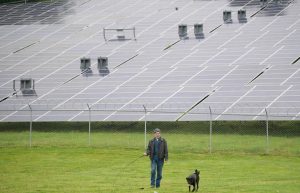
For Toku Oshima, a hunter from Greenland, the quest to bring renewable energy to her hometown of Qaanaaq is not just a fight against climate change — it’s a fight for cultural survival.
In 2015, Oshima journeyed from Qaanaaq — the northernmost town in the country — to a climate conference in Ilulissat, about 1,000 kilometres to the south. She had wanted to discuss how Earth’s rapidly changing climate threatened traditional ways of life in Greenland, such as Indigenous forms of hunting and fishing. But she came away also thinking about how to tackle another existential crisis facing Qaanaaq: energy security.
Like many residents in the Arctic, the town’s people struggle to pay for the fossil fuels they need to heat and power their homes, compounding many of the other pressures they face. In the past few years, hunters have found themselves unable to afford to feed their sledge dogs. And some residents are relocating to escape financial and mental depression. In the process, Oshima says, many Greenlanders are losing touch with their communities and culture.
At the conference, a friend told Oshima that she’d seen a presentation in which Mary Albert, a snow physicist at Dartmouth University in New Hampshire, had discussed climate-change evidence that’s preserved in ice cores. Albert had mentioned that transitioning to renewable-energy sources could help to curb the climate crisis, and had shown a picture of her own home decked out with solar panels. Oshima approached Albert during a coffee break, thinking that the scientist might have ideas about how to cut energy costs in Qaanaaq.
Albert was at first dubious that she could help. But as she opened her mouth to explain that renewables weren’t her speciality, she thought to herself: “What a cop out. You have a PhD in engineering. Are you really going to tell these people there’s no way you can help them?”
That marked the beginning of a collaboration between Albert and Oshima to help ween Qaanaaq off fossil fuels. In the past few years, Albert has recruited students at Dartmouth to work on a range of projects, including designing energy-efficient homes and testing the town’s potential for solar energy. And this month, Albert is heading to Qaanaaq to test newly developed solar and wind devices that she hopes will one day heat homes there.
For both women, this project is about more than one town. Researchers and communities from Siberia to Canada’s Northwest Territories aim to bring renewables to the Arctic. For scientists, that means designing technology that can work in places where the sun might not shine for months and temperatures stay decidedly below freezing for most of the year.
Although Greenland has made great strides in installing renewables, these changes have so far mostly benefited larger communities in the south of the country. Making cheap, accessible renewables work in Qaanaaq has the potential to “be good not only for this community, but for all Arctic areas”, however remote, Oshima says.
At the top of the world
About 1,400 kilometres south of the North Pole, Qaanaaq was founded in 1953 after the US Air Force gave around 100 Inughuit people living in a town near the newly built Thule Airbase just a few days to pack up and head to Greenland’s far north. Today, many of the town’s approximately 600 residents help with the day-to-day running of Qaanaaq by, for instance, teaching at its school or operating its water plant. A dwindling number still make a living off the land, using dog sledges to travel out onto the thick sea ice in search of seals and halibut.
Among them is Oshima, who was born in Qaanaaq in 1975 to a family of hunters. Although she left to study electrical engineering in Greenland’s capital, Nuuk, she eventually returned. She now hunts and runs a workshop where she cures skins and butchers meat. “I’ve never been an inside woman,” she says. “Here, there are more chances to go out into nature.”
Like everyone else in the town, Oshima relies on electricity produced by the town’s diesel generators. This is common in remote Arctic communities that were established after the Second World War, says Sherry Stout, a programme manager for Arctic strategies at the National Renewable Energy Laboratory in Golden, Colorado. Towns that emerged during this period often installed diesel generators because the fuel is less volatile than other types, and easier to transport over long distances, she says.
But getting diesel to such a remote location isn’t easy. Like many Arctic communities, Qaanaaq is not connected to the rest of the world through roads. Almost everything that the town doesn’t itself produce — including its supply of diesel — arrives on an icebreaker ship. Two deliveries take place each year, both in the Arctic’s late summer, when sea ice is at its lowest.
“Most communities only have one shot at getting all the diesel they need for the year,” says Martha Lenio, a renewable-energy specialist in the World Wildlife Fund’s office in Iqaluit, Canada. Increasingly erratic weather and sea ice sometimes means that the ships the communities rely on never come in. In 2019, unusual ice conditions prevented barges from making their annual diesel delivery to several hamlets in Canada’s Northwest Territories; in the end, the shipment had to be flown in.
Diesel despair
These logistics explain why the cost of fuel is so high in Arctic communities, Stout says. Making electricity from fossil fuels in the United States costs about 14 cents per kilowatt hour, on average. But in northern parts of Alaska, that price jumps to between 50 cents and US$1 per kilowatt hour.
Residents in Qaanaaq spend a considerable amount on fuel; sub-zero temperatures mean houses must be heated nearly continuously. Complicating the situation is that many of Qaanaaq’s houses are Danish-style — some of them dating back to 1953 — and these are not efficient at holding in heat.
To bring costs down, Greenland’s government heavily subsidizes fossil fuels, says Niels Erik Hagelqvist, a renewable-energy adviser at Nukissiorfiit, the country’s state-owned energy company in Nuuk. But even subsidized diesel — whose price equates to around 24 cents per kilowatt hour in US currency — is a significant expense for Qaanaaq’s residents, especially hunters who make little money selling their excess catch, Albert says.
“It’s not a simple life if you want to stay here,” Oshima says. “It’s very expensive.”
Which is one reason why Oshima would like to bring renewables to Qaanaaq. But finding the funds to make this transition is tricky. Greenland announced in 2017 that it planned to switch to renewables as much as possible by 2030. But all technologies have to be shipped in, says Hagelqvist, making these projects extremely costly. And with Greenland still dependent on funds from Denmark — it was a colony of Denmark but won home rule in the late 1970s — “our ambitions are limited by a lack of money”, he says.
This, in part, explains why Greenland’s 5 hydroelectric dams and 13 solar panel farms are concentrated in the more populous southwestern part of the country, where they can benefit the largest number of people (see ‘Going Green’). Small, northerly communities such as Qaanaaq typically need to raise their own money — or apply for government grants — if they want to make renewable energy a reality. And this can be risky, says Robert Cooke, a technology officer at the Canadian High Arctic Research Station in Whitehorse, Canada.
For instance, in 2007, the small Alaskan community of Nikolski built a wind turbine using a government grant, but the turbine sat unused for years because technicians struggled to connect it the town’s power-plant control panels. Most renewables were not built to handle Arctic conditions, Cooke says, and if a system is damaged, “it can be weeks before somebody can fly in and fix it”.
Prototypes on the way
Albert and her students hope to get round these problems by building technologies that Qaanaaq’s carpenter — Oshima’s husband — can easily install and fix.
Two of the group’s devices will be tested in Qaanaaq this month. One of these prototypes, designed by Albert’s student Simon Oster, uses wind energy to generate heat. Other renewable-energy projects in the Arctic, such as the Chaninik Wind Group in Alaska, do this already using electricity produced by wind turbines. But Albert says that Oster’s device is different because it generates heat directly from wind. Similar designs have been suggested before, Oster says, but none has reached the prototype stage. His own design is “top secret” for now, so he can’t discuss it.
Albert hopes that the wind device could be used in the dark of winter to reduce heating costs. And in the summer, homes could generate heat using the second prototype. This one, designed by Dartmouth student Tucker Oddleifson, is a type of window that traps solar heat. The idea is not new, but Oddleifson says that these particular windows are simpler than other designs and are built to make the most of the Arctic summer’s 24 hours of sunlight. The team hopes that, eventually, “these small-scale devices could be used anywhere”, Albert says.
Oshima and the researchers are not under any illusions that their project will solve all the town’s challenges. But the devices could go a long way to helping Qaanaaq’s residents have an easier life and continue to “live in northwestern Greenland, where their people have lived for thousands of years”, Albert says. “They want to be warm and comfortable — and they want to be able to afford it.”





